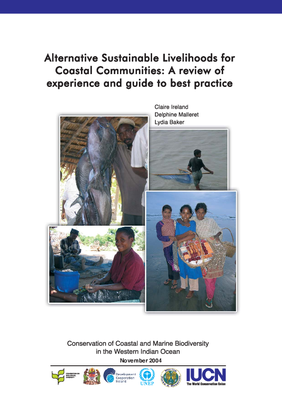Alternative Sustainable Livelihoods for Coastal Communities: A Review of Experience and Guide to Best Practice

Author(s): Claire Ireland, Delphine Malleret, and Lydia Baker
Publication Date: 2004
Location: Africa: Comoros, Madagascar, Mauritius, Mozambique, Tanzania. Asia: Indonesia, Maldives.
DOWNLOAD FILE
Key points in document
- The review provides background on coastal and marine livelihoods and an early assessment of the alternative livelihoods or income generating activities in place for coastal communities in Southeast Asia and Eastern Africa.
- This review defines conservation enterprises as a subset of alternative livelihoods.
- The review provides lessons learned from four countries addressing coastal livelihoods in marine protected areas and a step-by-step process which offers guidance and considerations for practitioners intending to develop alternative livelihoods initiatives.
- The document highlights the need to focus on the enabling environment during the development phase of alternative livelihoods.
- Case studies note which factors were in place for a successful project and which factors may have inhibited the livelihoods initiative.
- Facilitating better access to micro-credit, introducing and developing enterprise skills, and strengthening resource rights are common themes associated with alternative livelihoods success.
- This review was developed by USAID’s Sustainable Coastal Communities and Ecosystems (SUCCESS) project, implemented between 2004 and 2008.
Information relevant to Learning Questions:
Are enabling conditions in place to support a sustainable enterprise?
- Stakeholder alignment
- Market demand, profit potential, access to credit/capital
- Policies for enterprises, business alliances
- Technical capacity
- Inputs, equipment, infrastructure
- Benefit sharing, targeted participants, combined strategic approaches, biodiversity linkage, policies for and enforcement of resource use, planning for external disturbance
Does the enterprise lead to benefits to stakeholders?
- Increased income for participants
- Non-cash benefits
Do the benefits lead to positive changes in attitudes and behavior?
- Attitudes regarding sustainable use of resources
- Behaviors regarding sustainable use of resources
Does a change in stakeholders’ behaviors lead to a reduction to threats to biodiversity (or restoration)?
- Residential and commercial development
- Agriculture and aquaculture
- Energy production and mining
- Biological resource use
- Pollution
- Climate change and severe weather
Does a reduction in threats (or restoration) lead to conservation?
- Forest ecosystems
- Marine ecosystems
- Species


